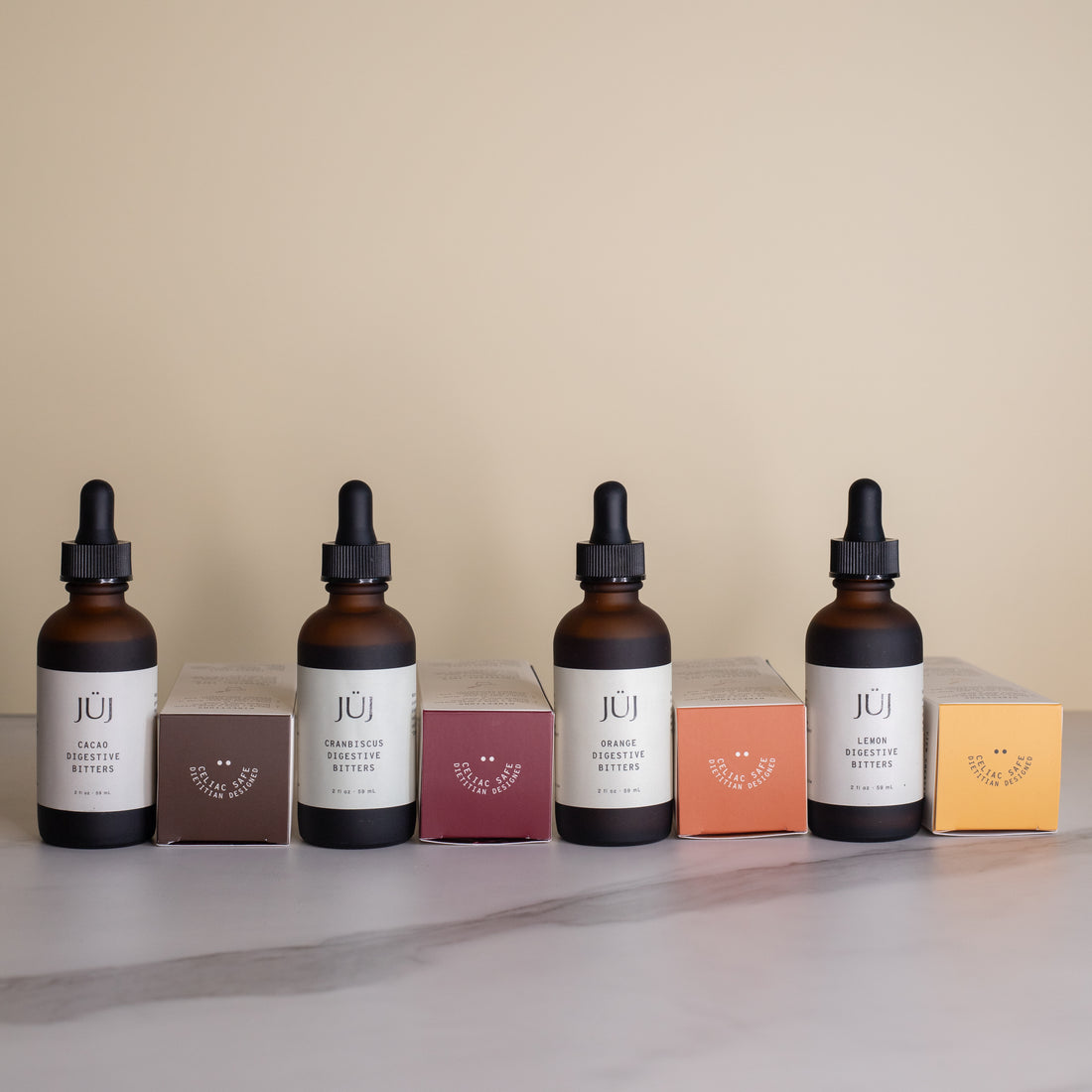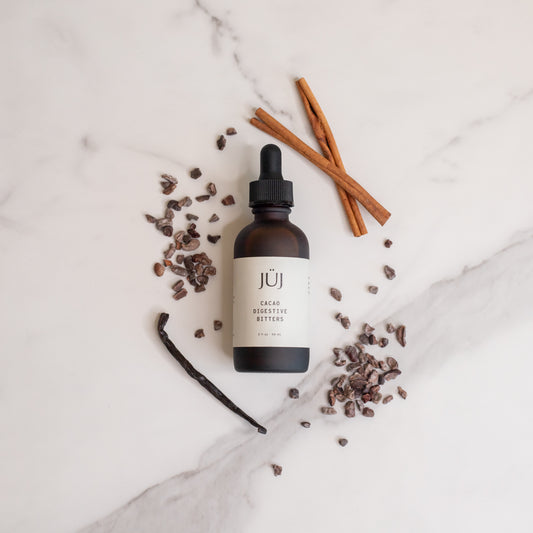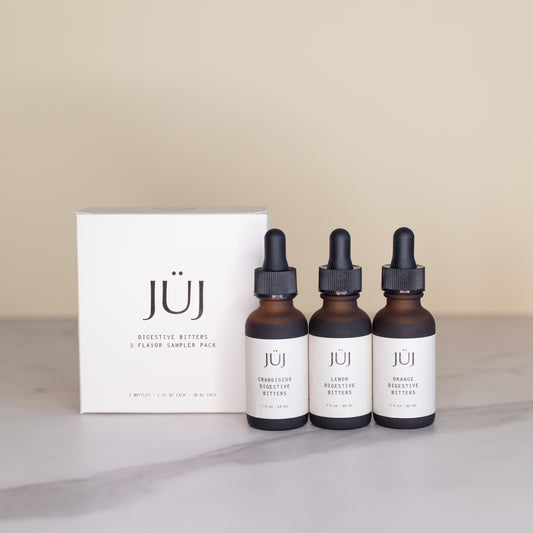A brief history of digestive bitters and what makes JÜJ better
PS if you're brand new to bitters, check out our Complete Guide To Bitters here
Ah, bitters.
The word rings with a bit of a negative connotation in our culture. After all, bitter foods have become an outcast of the American diet and culture over the years. And bitter people? Forget it. They are OUT! The 2 most consistent ways we intake anything bitter in our country are via:
1) Salads
Unlike what your friend who just studied abroad in Europe will tell you, salads are in fact meant to be served BEFORE dinner. They have the very intention of beginning the digestive process with bitter flavors. Today’s greens are not what they once were; they’re now super fancy or we douse them in ranch dressing. But you CAN bring back the bitter: think things like Radicchio, radishes, and cranberries.
2) Pre-meal cocktails
My fancy friends in Manhattan call these “Aperitifs”. If you really taste and take in the pre-meal cocktails you order at a bar, they are in fact bitter! They’re intended to do exactly what we’ll be talking about. And thanks to Jüj, you can make pre-meal mocktails instead!
I’m a bit of an exception. You see, I LOVE the taste of most things bitter. But I didn’t start there; I started by falling in love with what bitters can do for my body, and over time the rest of my body caught up and adjusted accordingly. Now bitter tastes are something I seek out.
In order to get the true benefits of "bitters," we must TASTE the bitter. If there’s only a few things you take away from this article, I’d want this to be one of them.

You see, “bitter” is also a taste receptor on the tongue- along with salt, sweet, savory, and sour. The general rule of thumb in the body is: if you give more signal to a cell surface receptor (in the form of a food/the flavor that lights up one of the 5 taste receptors), it tends to begin making LESS of those taste receptors. This is part of why we develop tolerance to substances (i.e. sugar) and over time we need more of the substance to get that same “hit.”
Here’s what’s fascinating (or maybe just fascinating to a nerdy herbalist like myself): bitters are the exception to this. If you stimulate the bitter receptors more and more on the tongue, your body actually begins producing MORE receptors.
Simply by tasting bitters more, we become more welcoming and open to bitter flavors, and in turn their positive effects on the body.
So how did I start loving the taste of bitters? I learned all of this, among many of the other positive effects of bitters on the body, and decided I needed more of them in my life. Studies on bitters have shown us countless benefits, including how consistent use can lead to significantly lower obesity rates and an ability to more easily control eating.
Bitters, in a nutshell, begin the digestive process before the meal begins.
They signal to begin creating digestive enzymes before your first bite, and make the whole system flow more smoothly. If you utilize bitters during or after your meal, it continues to have wonderful benefits. Without bitters, before a big dinner, there's no signal that tells your body: "big meal incoming, get ready to digest!" The body isn’t prepared for the incoming food, and this is part of what can lead to unwanted GI responses (such as bloating).
This concludes story time and begins our dive into the wonderful bitter formulas crafted by Alex & Meg at Jüj. I am highlighting some of the more essential herbs in these formulas, although all formulas are a sum of its parts (so know that all the herbs in the formulas are serving an essential purpose

1. Cranbiscus Formula
If I were beginning my bitters journey all over again, I would have liked to start here. This is a wonderful blend that tastes rather pleasant while still giving a true bitter taste. Cranberries are a great bitter food to utilize!
-
Gentian Root
-
Probably THE chief pre-meal bitter, & at the heard of many bitter formulas
-
Improves the assimilation of nutrients (especially B12 and Iron), and aids in the breakdown of proteins and fats
-
Has a long history of use for arthritic conditions & joint inflammation
-
Dandelion Root: What does dandelion NOT do?
-
A chief facilitator in increasing bile secretion from the liver
-
Roots are rich in minerals
-
Helps complete its own detox cycle when it removes waste products from the gallbladder and liver as it simultaneously stimulates the kidneys to remove toxins through the urine
-
Licorice Root
-
Known in Chinese Medicine as “The Great Harmonizer,” it’s often used to bring together and enhance the effects of other herbs
-
These formulas are a sum of their parts, and Licorice is an herb that helps 1+1=3
-
Aids the liver, gently encourages bowel movements, and both a preventative & treatment for nausea

2. Orange Formula
This is your middle ground. Still some really nice flavors but… starting to get bitter! Personally I love this one.
-
Ginger
-
Like Licorice, a harmonizer (known as a “catalyst”). It’s often used in formulas to enhance the properties of other herbs
-
Aids with nausea, motion sickness, cramps, indigestion, and better stimulation of digestive secretion
-
Helps with gut motility: essentially helping the whole process to relax, run smoothly, and keep the intestinal muscles contracting and expanding on schedule
-
Fennel Seed
-
If you’re ok with its taste, it’s a wonderful tea to begin drinking on its own for anything related to digestion
-
I describe Fennel Seed as helping to get everything back towards normal:
-
Helps diminish gas, bloating, stagnation, constipation, stabilizes blood sugar, and decongests the liver
-
Clove
-
Cloves help to warm the body, cleanse the liver, and treat gas and nausea
-
Allspice is in fact a substitute for Clove; not just in taste, but in the majority of its principal herbal actions

3. Lemon Formula
This, as highlighted by its main herbs, is going to be your most bitter of the 3. Do you dare???
-
Milk Thistle
-
Not only does it detoxify the liver, but it can help rebuild the liver (you heard correctly, my bitters disciples)
-
It’s resilient and wonderful, and so are you
-
Keeps things flowing and regulated in the liver, prevents toxins from building up there, and improves overall liver function
-
Burdock (This is personally one of my favorite herbs)
-
Does very well when combined with Dandelion and Yellow Dock, as it is here
-
An excellent blood purifier, aids in increasing bile flow from the liver, & gently encourages bowel movements
-
Aids the liver by bringing a wealth of minerals to it
-
Yellow Dock Root
-
Has been called “quite possibly one of the best herbs for the entire digestive system including the liver”
-
If you’re constipated, have headaches at your forehead, or have toxins backed up in your liver, Yellow Dock is an herb to talk to your practitioner about
-
Works best at relieving liver congestion & inflammation in the liver or gallbladder
-
*I caution the use of this herb by itself if you’re new to using herbs. I love it but it is STRONG!
I could write a book about bitters, but this is all I have for you today. Until next time, Bitters Warriors.
Interested in trying all 3 JÜJ flavors? We recommend our 3 flavor sampler pack!
This blog is for informational purposes only and should not be considered professional medical advice.
Written By Tim Peters
Tim Peters is a Certified Herbalist and the Founder of Mind Body Business. He provides 1 on 1 business coaching along with copy editing and content writing for alternative health professionals. If you want to connect with him or learn more about him:
Tim@mind-bodybusiness.com
www.mind-bodybusiness.com
Let's connect on IG!




